Читать книгу Zen Shaolin Karate - Nathan Johnson - Страница 9
На сайте Литреса книга снята с продажи.
ОглавлениеIntroduction
Karate has become a household word in many countries of the world. It is a far cry indeed from the days when it was practiced as an obscure Okinawan village art. As a word, karate simply means empty hand (kara = empty, te- hand). Karate originated in China where the empty-hand arts grew as an extension of the ancient teachings of the Ch'an (Zen) monks of the Shaolin Temple. In fact, the true teachings reflect this ancient wisdom in a practical way. If a system is stripped of its essential philosophy, it becomes nothing more than a gross collection of methods for brutalizing our fellow human beings. Fear is a poor substitute for respect.
The great classics in any art form serve as a source of inspiration to the succeeding generations. They are the bedrock upon which future developments depend. True karate teachings can be said to be contained in the original solo forms, or kata, which preserve the classical art. Of the utmost importance in the preservation of these classical kata is the soul of each form, its practical function.
This book is about classical karate. However, far from being dry or safe, it is controversial. It breaks totally new ground, not through innovation but through the restoration of the neglected practical applications of two of karate's oldest and most profound kata. These are woven together to form a concise and highly practical system that remains true to the wisdom of the Shaolin Temple and that is enjoyable to learn and practice.
This bookreveals the Chinese origins of karate and how to unite and apply all the techniques shown. Most of these kata applications have never been published in English. You are invited to try them for yourself, and if you like them, to make them your own.
Chapter One of this book deals with the Shaolin Way and the history and background of karate. Chapter Two deals with basic techniques and exercises. Chapter Three deals with the Saam Chin kata and Saam Chin boxing (boxing is given to mean punching, striking, kicking, and deflecting). Chapter Four deals with the Nai Fuan Chin kata (note that this is in fact three kata in one) and Nai Fuan Chin grappling (joint locks, restraints, and throws). Chapter Five deals with the ultimate combination of the techniques in Chapters Two to Four through the medium of pushing hands, which forms the bridge or link between kata and application.
The karate in this book can be categorized as Zen Shaolin Karate, which means the empty-hand (way) of Shaolin meditation. It is not a style, however, but a living principle. Its major characteristics are strict adherence to Zen principles, and a refusal to use self-generated power or to initiate an attack. In fact, Zen Shaolin avoids direct confrontation (in which the strongest win), instead seeking the watercourse way (the line of least resistance), flowing with the lines of force, and turning an opponent's force back on him. In so doing, the need to become aggressive is removed.
Using genuine applications, you can also overcome the limitations of strength because you will not be using it! You will learn how to absorb your opponent's force, borrow, and then give it back, the whole process being done instantly by contact reflex while the mind is dispassionately fixed in the meditational state known as samadhi. If you find your body is flowing with the force of an attack, not resisting or blocking, but rerouting it, and if you find calmness amidst physical action, then you will have discovered the watercourse way for yourself. Your own understanding will lead to your own true karate-do.
Gassho
Nathan J. Johnson
Kai San, Zen Shaolin Karate Renmei
The University of Southampton
